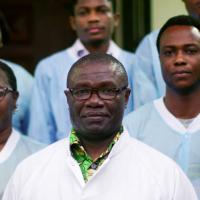What if there was a way to fast-forward scientific innovation? Today, it typically takes about a year for scientists to receive a research grant, no matter how brilliant the idea.
To submit a grant proposal to the National Institutes of Health — the government-run, largest funder of biomedical research in the world — applicants often spend copious amounts of time getting every minute detail just right. Studies estimate that researchers spend 25 to 50% of their time simply writing applications.
While there are options outside of the NIH for funding, most of them have similarly intensive grant application requirements, slowing down scientists’ ability to get started on projects that could have major implications in society.
During the onset of the COVID-19 pandemic, the problems with this extremely slow system came to the forefront of the science world. When time is of the essence, this timeline isn’t feasible and could prove to be dangerous.
To pave the way for speedier innovation, an economist and tech billionaire joined forces and came up with Fast Grants, which made coronavirus research funding more easily accessible in a time when it mattered most.
Supercharging COVID-19 Research Grants
Patrick Collison, the CEO of Stripe, and Tyler Cowen, the director of Mercatus Center, saw that the inefficient system for obtaining research grants wasn’t keeping pace with the ever-changing landscape of the pandemic.
That was all the motivation they needed to start Fast Grants — a medium that allows scientists to apply for and receive grants between $10,000 and $500,000 in 14 days or less.
Cowen and Collison were able to strip away restrictive red tape and revolutionize the way grants are awarded. What once took months now takes just hours and days.
“(The pandemic) was a case where urgency really mattered,” Cowen explains. “With thousands of people dying every day, every day matters. And the ideas and technologies that could help have been lacking in speedy funding.”
It all started in April 2020 when the duo realized that, surprisingly, there wasn’t a single concerted effort to expedite COVID-19 research grants. Within hours of their initial conversation, they decided to launch Fast Grants, which went on to provide over 200 grants in the seven months that followed. That’s almost one grant per day.
In the next six months, the team has plans to catalyze up to 115 research projects, accelerating timelines by as much as nine months. In many cases, these projects would otherwise go unfunded.
In order to apply for a grant, researchers must be a principal investigator at an academic institution and working on a project that could have an immediate impact on the COVID-19 pandemic, ie. within the next six months. They must also be in need of additional funding to complete their project.
After filing a simple application that most can complete within an hour, their proposal is sent to a panel of scientists tasked with approving or denying the grant. If the application is approved, researchers are able to receive funds as quickly as their institution can process the payment.
“Giving the right $10,000 to the most deserving person — that can actually change the world,” Collison said. “Fast Grants is the antithesis of Big Science. It’s not a billion dollars to one giant, centralized effort. It’s smaller grants placed as expeditiously as possible to make the next significant discovery.”
And significant discoveries were indeed made. The startup’s COVID-19 research grants helped further the world’s understanding of the virus and funded everything from genetic testing to vaccines.
While applications are currently paused due to a large number of submissions, Fast Grant’s impact has already reverberated throughout the scientific community, and the world as a whole.
Faster Grants Lead to Faster Innovation
The COVID-19 research grants provided by Fast Grants have fueled some of the biggest scientific advancements to date, perhaps most notably — the saliva test. It was developed by a group of researchers from Yale led by Ann Wyllie, who discovered a faster and cheaper way to test for the virus without having to extract RNA.
While a spit test had already been developed, it was very expensive and wasn’t quick. Yale’s version of the test costs just $10-15 to run, as opposed to $150, and it’s now open source.
The test was used during the NBA playoffs bubble in Orlando, Florida, where players were sequestered and tested more frequently to ensure their safety. Today, the spit test is being used in labs throughout America.
Other COVID-19 research grants allowed vaccines to be developed within one year, the discovery of a genetic mutation that caused severe reactions to the virus, and studies that gauged its impact on communities across the globe.
Collison and Cowen hope that Fast Grants can serve as a blueprint for how we address future public health challenges.
“COVID-19 is not going to be our last pandemic. That 19 suffix is important for a reason,” Collison said. “We want Fast Grants to be situating us for the next pandemic so we will all be better prepared to fight that battle, too.”
Thanks to speedy funding from Fast Grants, the science community was better equipped to face major obstacles during the pandemic. And now, as the world moves forward, the process for funding scientific research could be changed forever.
Stand Together helps social entrepreneurs supercharge their efforts by connecting them with passionate partners and the resources necessary to make a greater difference.
Through Stand Together’s philanthropic community, they’re tackling some of the nation’s biggest challenges so that every person has the opportunity to realize their full potential.
Learn more about getting support for your business, or become a partner today at StandTogether.org.



